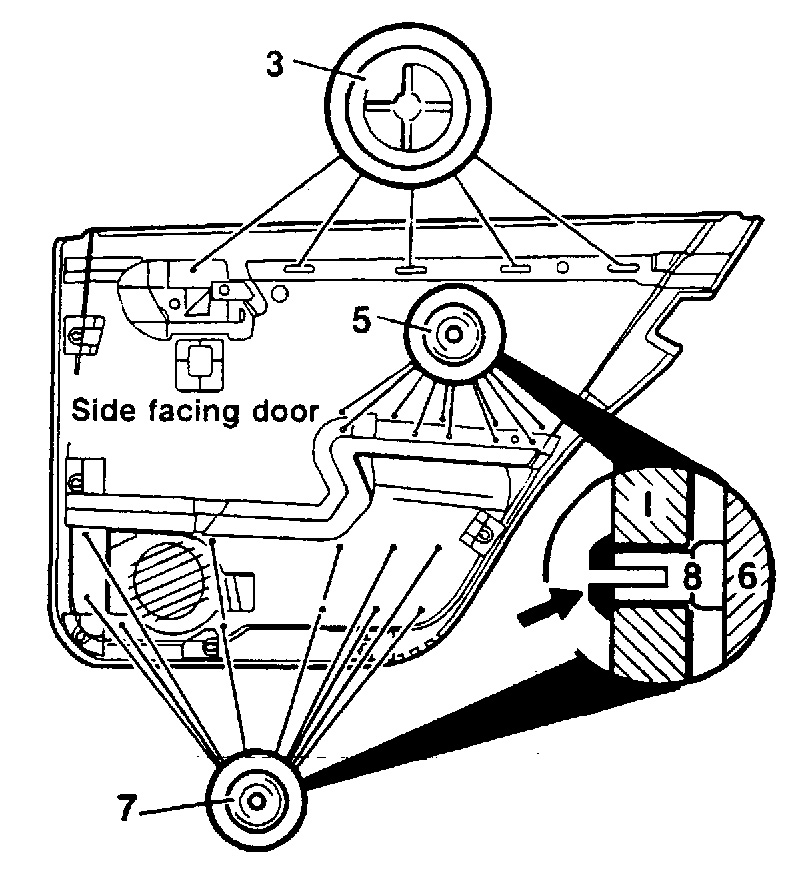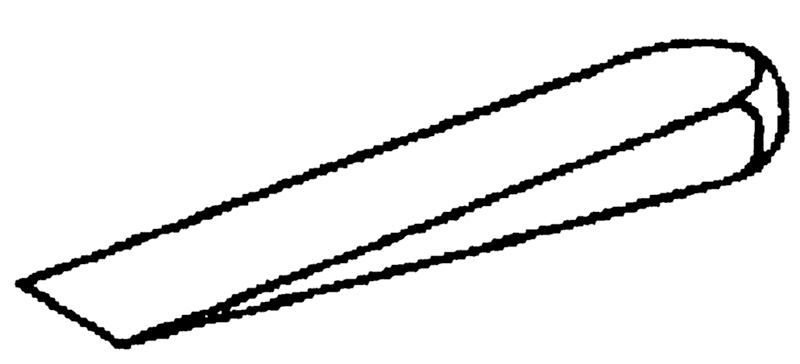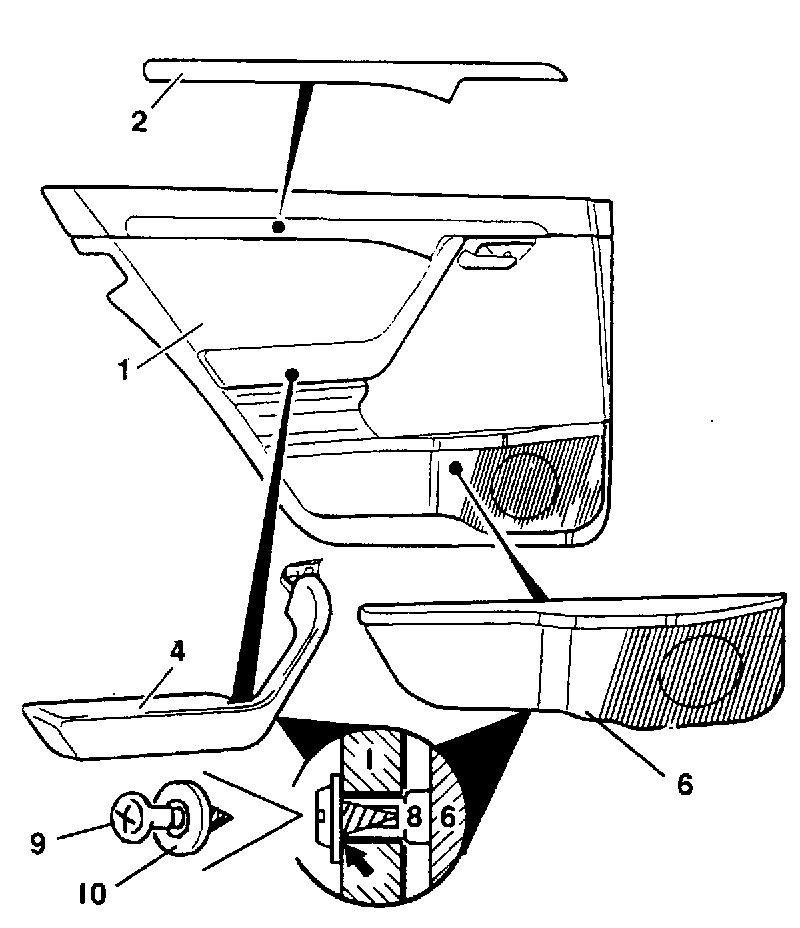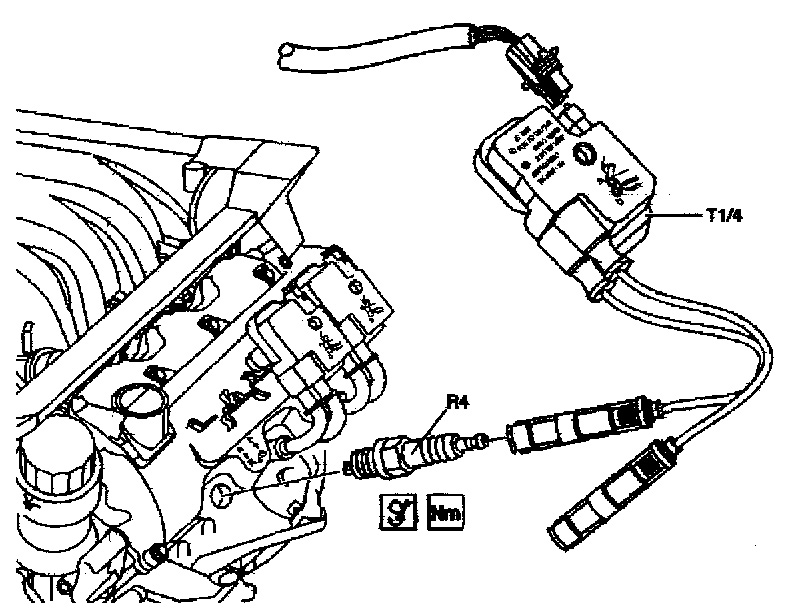These suggestions and solutions for technical problems come from service bulletins published by Mercedes-Benz, selected and rewritten for independent repair shops. Your Mercedes-Benz parts source can obtain any designated by parts number.
 Rear Interior Door Panel Disassembly
Rear Interior Door Panel Disassembly
Model 202
If you have to open up these rear doors for testing or repair, you probably would like to buy a minimum number of replacement parts, preferably only inexpensive fasteners. Here’s the technique:
 Remove the panel using a plastic wedge and unscrewing the Philips screws in the locations shown in the line drawings. Â There are several door interiors, but the attachments are similar. Place the panel you removed on a clean surface to avoid getting anything on the side that shows. The inside of the panel should be upward, the visible face downward.
Remove the panel using a plastic wedge and unscrewing the Philips screws in the locations shown in the line drawings. Â There are several door interiors, but the attachments are similar. Place the panel you removed on a clean surface to avoid getting anything on the side that shows. The inside of the panel should be upward, the visible face downward.
Remove the wood trim locks (3) from the door panel back and carefully remove the wood trim from the panel. Be careful with the wooden parts because the color is hard to match, particularly after a few years (they were different trees).
 Use side snips or a 5/8-inch chisel and small hammer to remove the rounded portion (arrow) of the white plastic mounting studs (5) for the armrest. Gently and carefully, remove the armrest from the door panel. Since the white plastic studs are soft, don’t use a drill to remove the rounded tips because the bit will penetrate the plastic too deeply, and you may not be able to re-use the armrest.
Use side snips or a 5/8-inch chisel and small hammer to remove the rounded portion (arrow) of the white plastic mounting studs (5) for the armrest. Gently and carefully, remove the armrest from the door panel. Since the white plastic studs are soft, don’t use a drill to remove the rounded tips because the bit will penetrate the plastic too deeply, and you may not be able to re-use the armrest.
Use a slow turning 10-mm drill bit to remove the corresponding rounded tips of the black plastic studs for the door pocket. Gently and carefully, pull the door pocket away from the interior door panel.
Putting things back together, insert the armrest and door pocket into the panel. Cut off the ends ofthe inside surface of the panel any of the studs, white or black, that of the studs flush with the surface.
The ends of each of the black and white studs should be exactly flush with the door panel surface when properly installed.
Put a washer [p/n N 000125 005312 (210)] over each of the white/black plastic mounting studs. Thread in and tighten a screw [p/n N 914138 004000 (21)] into the existing bore of the studs. Reposition the wood trim into the panel and secure with the wood trim locks you removed originally. If any wood trim locks were damaged in disassembly, replace them or the wood trim may be loose.
MBNA 72/13
Soggy Rug, Sooty Exhaust?
Model 163 and Others
Model 163 is somewhat more likely than other Mercedes-Benz vehicles to end up with a wet carpet under the front seats from melting snow, water and the like because it is somewhat more likely to be used off-road. But the problem can affect any vehicle whose oxygen sensor harness routes through the compartment in that area. That moisture can start corrosion in the connectors for either oxygen sensor if it remains for any length of time.
If there is excessive corrosion on the terminals, replace them and cover the connectors with a watertight sealant. If you can clean the terminals for a good connection (and remember, an oxygen sensor does not have a very high voltage or current, so any resistance will affect the signal), just use the sealant, dry out the carpet and inform the car owner of the importance of keeping this area relatively dry.
10M/99-2
Coil Corrosion
All Models with Gasoline Engines
 If your diagnosis of an ignition problem leads you to the ignition coil, be sure to check all the connections, primary and secondary, to that coil. A high resistance connection, or even a connector that is not fully seated in the housing, can produce exactly the same symptoms as a defective coil. Worse still, when you replace a good coil with such a bad connection, you will probably connect the unnecessary new coil properly, making you think the coil really was needed. This test consists of a careful visual inspection of the coil and its connectors before you discard it.
If your diagnosis of an ignition problem leads you to the ignition coil, be sure to check all the connections, primary and secondary, to that coil. A high resistance connection, or even a connector that is not fully seated in the housing, can produce exactly the same symptoms as a defective coil. Worse still, when you replace a good coil with such a bad connection, you will probably connect the unnecessary new coil properly, making you think the coil really was needed. This test consists of a careful visual inspection of the coil and its connectors before you discard it.
04/98-4
False Failures
All models with LH-SFI or HFM-SFI, 1993-1996
Mercedes-Benz vehicles with the systems and from model years identified may fail OBD tests in some states that established their test procedures without knowing how these Mercedes-Benz systems operate. Certain localities automatically fail any vehicle if the MIL lamp is on with the vehicle in any key-on/engine-running condition or if the MIL comes on after the vehicle is started, even with no fault codes present (on the theory this represents a serial data link failure).
But certain Mercedes-Benz vehicles turn the MIL on during DTC readout and/or while the tool is connected, regardless of whether there are faults present in the OBD system or not. This feature was designed into the control modules for early OBD systems so a technician could tell when a tool properly communicated with the control module. In this case, the MIL is only illuminated as a test; it is not ‘commanded on’ as in any case when an emissions-related fault has been recorded. A list of affected vehicles is in the service bulletin listed here.
P-SI-14.00/14
Blown Fuse
Model 140
If you’re doing any kind of work that involves removal of the center console wood trim, you’ll remove the ashtray cover first. Most likely, you’ll turn the ignition key on and push the brake pedal so you can move the shift lever out of Park and have enough room to get in with an offset screwdriver. But if before you start to work, you take the precaution to then turn the ignition off with the shift lever still out of Park, you shut off the current to the cigarette lighter. Touching the terminals with the screwdriver could pop the fuse, of course, but you might not notice the bad circuit until the motorist brought the car back with that complaint.
MBNA 68/3
ABS and Cruise Control Diagnosis
Models 124, 129 and 140
If you’re diagnosing one of these models with ABS or cruise control, check to see whether it includes ASR (Acceleration Slip Regulation) before you get far into the job. Diagnostic testing of ABS on cars with that system is covered in the ASR section of the Diagnostic Manual, available from Mercedes-Benz Technical Information. Section 6 of the manual applies only to vehicles without ASR.
Similarly, the same models cover diagnostic information on the cruise control system within the ASR diagnostics, not separately. You’ll find it covered under the Electronic Accelerator test.
MBNA 30/5, 42/9






0 Comments